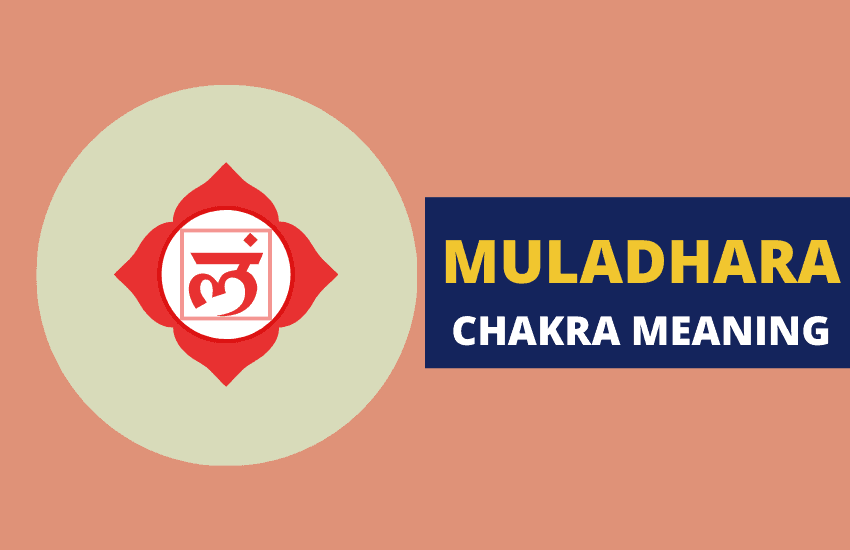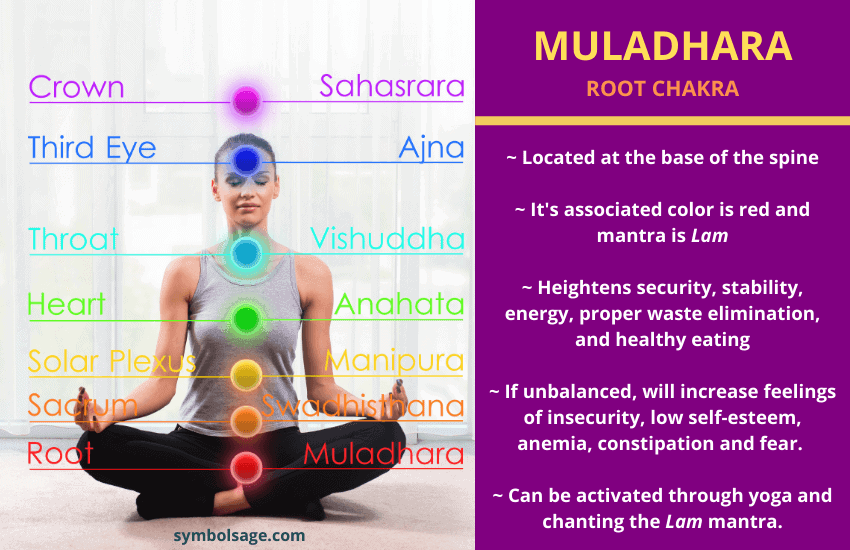
Table of Contents
The Muladhara is the first primary chakra, linked to the root and basis of existence. The Muladhara is where the cosmic energy or Kundalini originates and is located near the tail bone. Its activation point is in between the perineum and pelvis.
The Muladhara is associated with the color red, the element of earth, and the seven trunked elephant Airavata, a symbol of wisdom, which carries the creator god Brahma on its back. In tantric traditions, the Muladhara’s also called Adhara, Brahma Padma, Chaturdala and Chatuhpatra.
Let’s take a closer look at the Muladhara Chakra.
Design of the Muladhara Chakra
The Muladhara is a four petaled lotus flower with red or pink petals. Each of the four petals are etched with the Sanskrit syllables, vaṃ, śaṃ, ṣaṃ and saṃ. These petals are an emblem of the various levels of consciousness.
There are several deities who are associated with the Muladhara. The first is Indira, the four-armed deity, who holds a thunderbolt and a blue lotus. Indira’s a fierce protector, and he fights off demonic forces. He’s seated on the seven trunked elephant, Airavata.
The second deity who resides in the Muladhara is Lord Ganesha. He’s an orange-skinned deity, who carries a sweet, a lotus flower, and a hatchet. In Hindu mythology, Ganesha’s the remover of hurdles and obstacles.
Shiva’s the third deity of the Muladhara Chakra. He’s a symbol of human consciousness and liberation. Shiva destroys harmful things that are present within and outside us. His female counterpart, Devi Shakthi, represents positive emotions and feelings. Shiva and Shakthi establish a balance between the male and female forces.
The Muladhara chakra’s governed by the Mantra Lam, chanted for prosperity and security. The dot or Bindu above the Mantra is ruled by Brahma, the creator deity, who holds a staff, the sacred nectar, and holy beads. Both Brahma and his female counterpart Dakini, are seated on swans.
Muladhara and Kundalini
The Muladhara chakra has an inverted triangle, within which lies the Kundalini or cosmic energy. This energy patiently waits to be awakened and returned to Brahman or its source. Kundalini energy’s represented by a snake wrapped around a lingam. The lingam is Shiva’s phallic symbol, representing human consciousness and creativity.
The Role of the Muladhara
The Muladhara’s the energy body and building block for all functions and activities. Without the Muladhara, the body won’t be strong or stable. All other energy centers can be regulated if the Muladhara is intact.
Within the Muladhara is a red drop, which symbolizes feminine menstrual blood. When the red drop of the Muladhara merges with the white drop of the crown chakra, feminine and masculine energies come together.
A balanced Muladhara enables an individual to be healthy, pure, and full of joy. The root chakra reveals negative emotions and painful incidents, in order for them to be confronted and healed. This chakra also enables a mastery of speech and learning. A balanced and Muladhara chakra will prepare the body for spiritual enlightenment.
The Muladhara is associated with the sense of smell and the action of pooping.
Activating the Muladhara
The Muladhara chakra can be activated through yoga postures such as the knee to chest pose, head to knee pose, lotus flexion, and the squatting pose. The contraction of the perineum can also awaken the Muladhara.
The energy within the Muladhara can be activated by chanting the Lam mantra. It’s said that an individual who chants this more than 100,000,000 times, can attain spiritual enlightenment.
Mediation can be done by placing a precious stone on region of the Muladhara Chakra, such as the bloodstone, gemstone, garnet, red jasper, or black tourmaline.
The Muladhara and Kayakalpa
Saints and Yogis master the energy body of the Muladhara, by practicing Kayakalpa. Kayakalpa’s a yogic practice that helps stabilize the body and make it immortal. Saints master the element of earth and try to make the physical body similar to a rock, which doesn’t get weathered by age. Only highly enlightened practitioners can achieve this feat, and the Kayakalpa uses divine nectar to strengthen the body.

Factors that Hinder the Muladhara Chakra
The Muladhara chakra won’t be able to function to its fullest ability if the practitioner feels anxiety, fear or stress. There must be positive thoughts and emotions in order for the energy body within the Muladhara chakra to remain pure.
Those who have an imbalanced Muladhara chakra will experience problems with the bladder, prostate, back or leg. Eating disorders and difficulty in pooping can also be a sign of the Muladhara’s imbalance.
The Muladhara Chakra in Other Traditions
An exact replica of the Muladhara, cannot be found in any other traditions. But there are several other chakras that are closely associated with the Muladhara. Some of these will be explored below.
Tantric: In Tantric traditions, the closest chakra to the Muladhara lies within the genitals. This chakra creates immense, bliss, pleasure and joy. In Tantric traditions, the red drop isn’t found in the root chakra, but rather is located within the navel.
Sufi: In Sufi traditions, there’s an energy center located below the navel, which contains all the elements of the lower self.
Kabbalah traditions: In Kabbalah traditions, the lowest energy point is known as Malkuth, and is associated with the genitals and pleasure organs.
Astrology: Astrologists deduce that the Muladhara chakra is governed by planet Mars. Like the Muladhara chakra, Mars is also associated with the earth element.
In Brief
Notable saints and yogis have declared the Muladhara charka to be the very foundation for human beings. This chakra determines the vigor and wellbeing of all other chakras. Without a stable Muladhara chakra, all the other energy centers within the body will either collapse or become weak and feeble.








